Chapter 11: Experiments: Threats to Internal Validity Null effects
1/29
There's no tags or description
Looks like no tags are added yet.
Name | Mastery | Learn | Test | Matching | Spaced |
|---|
No study sessions yet.
30 Terms
Maturation threats to internal validity
a change in behaviour that emerges more or less spontaneously over time
people adapt to changed environments; children get better at walking and talking; plants grow taller - not because of any outside intervention, it just happens
improve on your own
preventing maturation threats
include a no-treatment comparison group
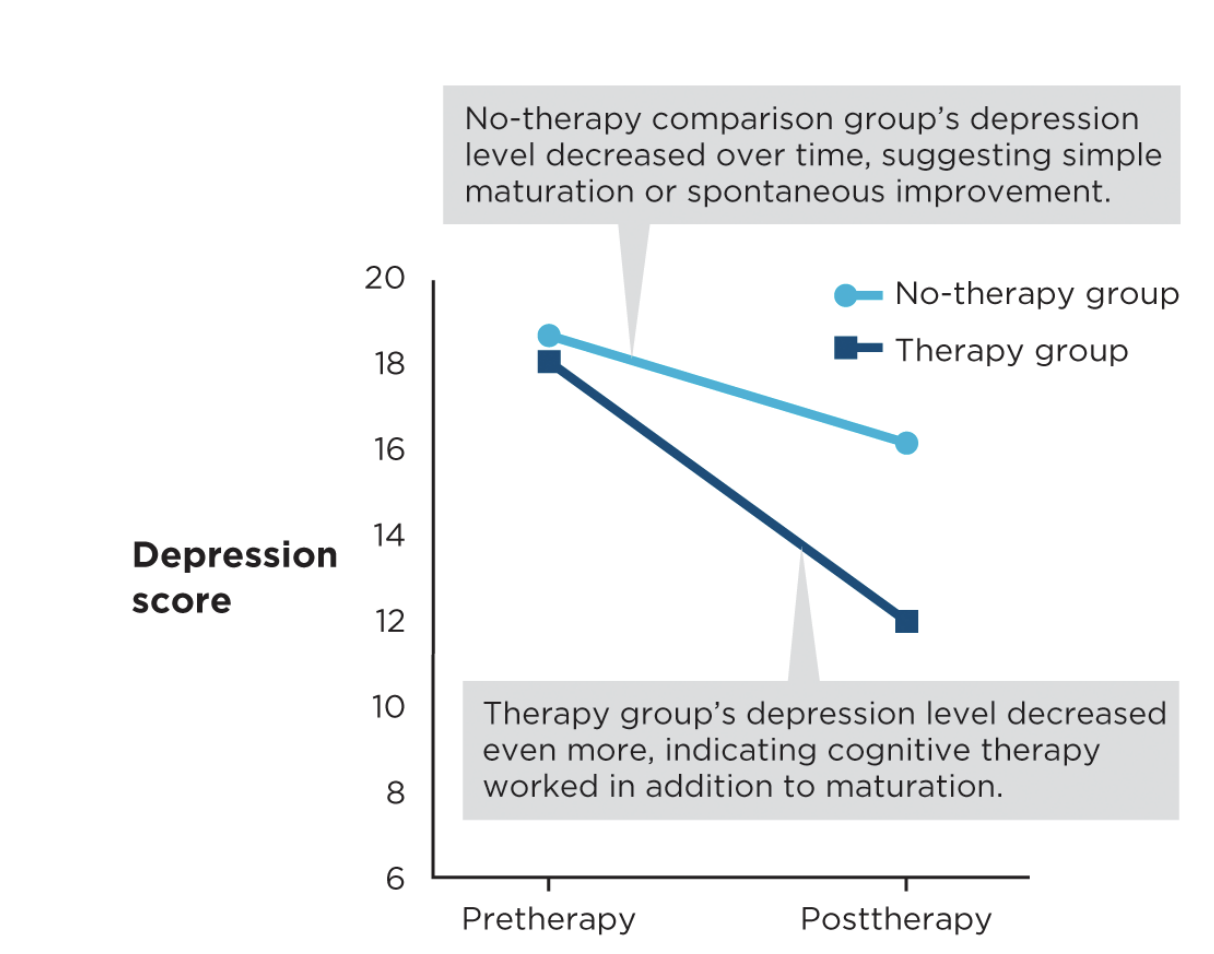
history threats to internal validity
a specific event (unrelated to the study) takes place between pre and post test affects everyone in the group
to be a history threat, the external factor must affect most people in the group in the same direction (systematically,) not just a few people (unsystematically)
preventing history threats
include a no treatment comparison group

regression threats to internal validity
regression threat: refers to a statistical concept called regression to the mean
when group average is unusually extreme at time 1, the next time that group is measured (time 2), it is likely to be less extreme - closer to its typical or average performance
extreme pretest (regardless of IV level)
less extreme at posttest
regression threats occur only when a group is measured twice, and only when the group has an extreme score at pretest
preventing regression threats
include a comparison group
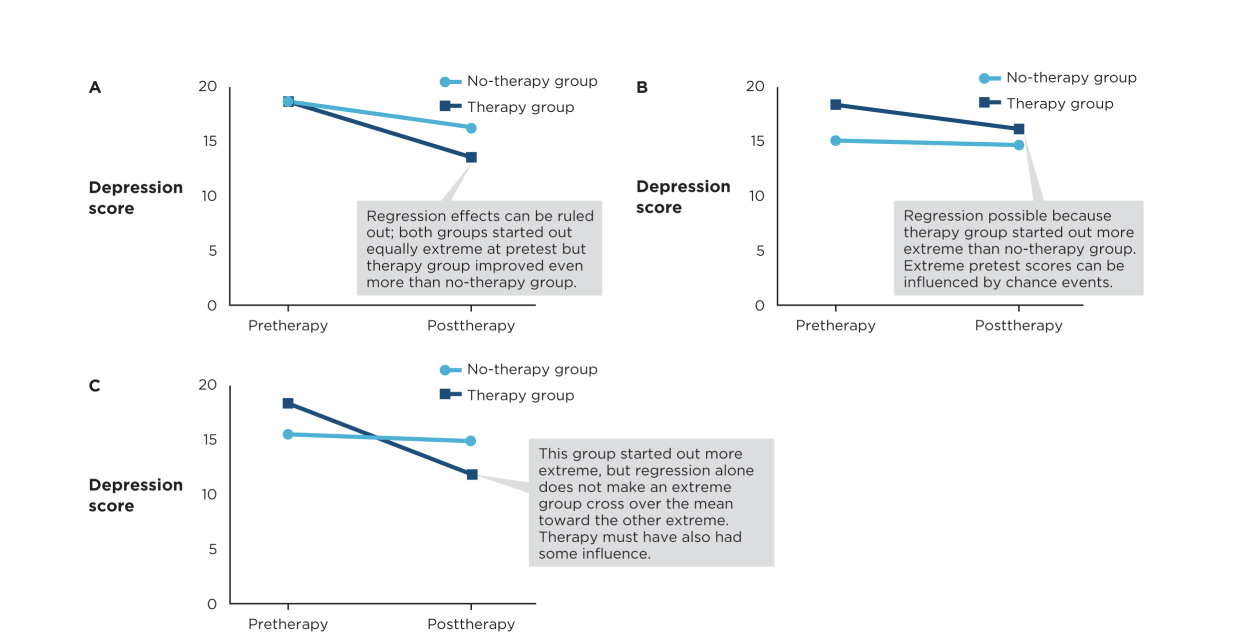
attrition threats to internal validity
can happen when a pretest and posttest are administered on sperepate days and some participants are not available for the second day
problem for internal validity when attrition is systemic; only a certain kind of (extreme cases) particular drops out
most shyest, depressed, worst behaviour, etc.
A) if 2 people (noted by blue dots) drop out of a study, both of whom scored at the high end of the distribution on the pretest, the group mean changes when their scores are omitted, even if all other scores stay the same
B) if the dropouts scores on the pretest are close the group mean, removing their scores does not change the group mean as much
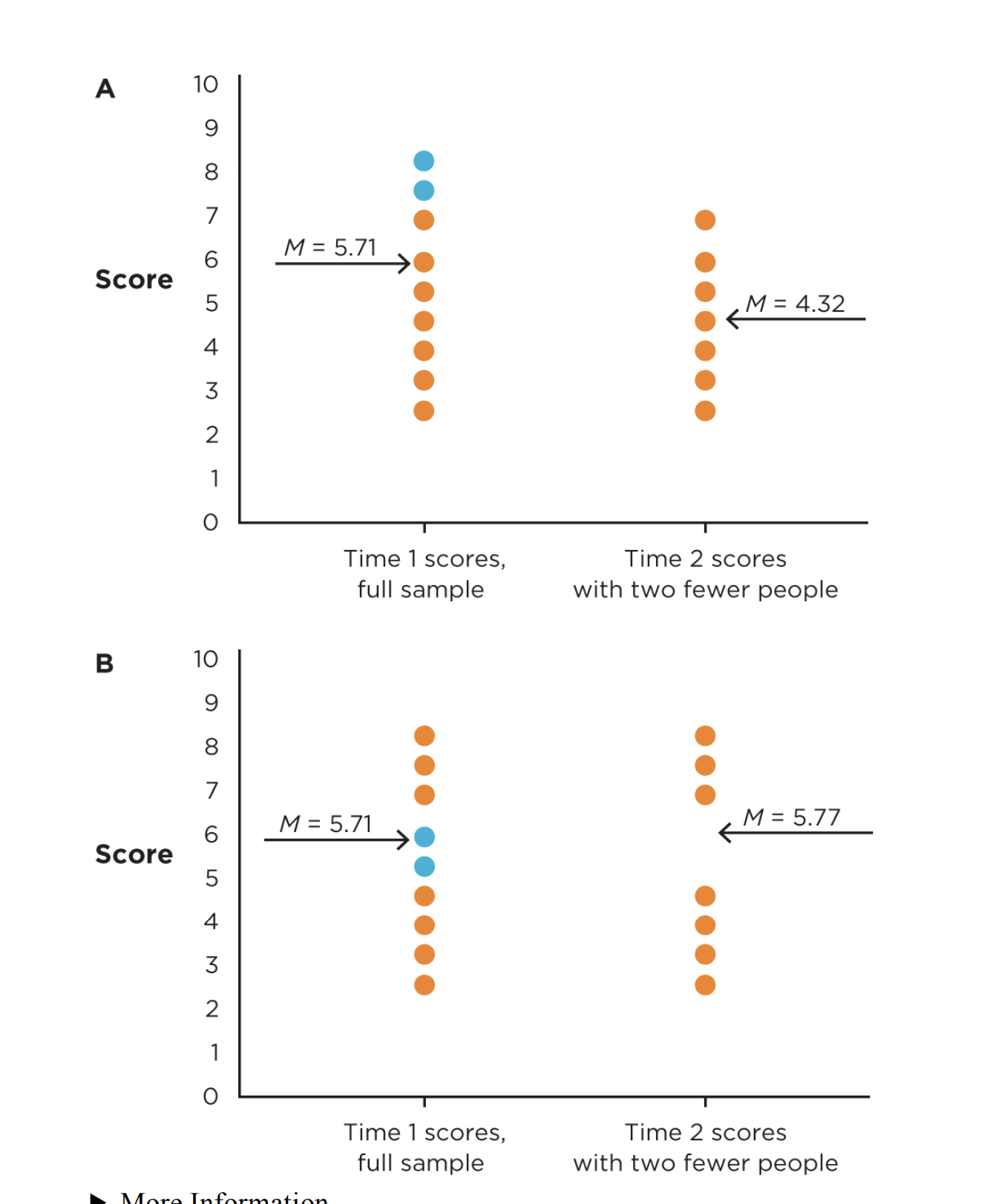
preventing attrition threats
how can attribution effects be identified: compare drop outs versus completers on the pretest measures to see whether attrition is selective or random
how can attrition effects be accounted for: remove participants who drop out from pre and post test analyses, do you see the same pattern of results?
testing threats to internal validity
people might have become more practiced at taking the test, leading to improved scores, or they may become bored, which could lead to worse scores over time
In education, students may score higher on a posttest than a pretest due to practice from the first test, not because of the intervention.

preventing testing threats
abandon a pretest altogether and use a posttest only design
use alternate forms of test at pre and posttest
use comparison group to rule out effect of repeated testing
instrumentation threats to internal validity
measuring instrument changes over time
people who are coding behaviours are the measuring instrument, and over a period of time, they might change their standards for judging behaviour by becoming stricter or more lenient
preventing instrumentation threats
posttest only design
calibrate forms to be comparable
establish reliability and validity at both pre and post test
counterbalance different forms across the pre and post test
threats to internal validity that can apply to ANY experiment
observer bias
demand characteristics’s
placebo effects
Observer bias
behavioural dependent variable
researchers expectations influence their interpretation of the results
may expect the low sugar diet to work so he views the boys posttest behaviour more positively
demand characteristics
problem when participants guess what the study is supposed to be about and change their behaviour in the expected direction
patients know they are getting therapy, if they think the researcher expects them to get better, they might change their self reports of symptoms in the expected direction
how to avoid observer bias and demand characteristics
conduct a double blind study: neither the participants nor the researchers who evaluate them know who is in the treatment group and who is in the comparison group
arrange to have 2 cabins of equally lively campers and replace the sugary snacks with good tasting low sugar versions for only one group
they wont know which kind of snacks they were eating, and the people observing their behaviour would also be blind to which the boys were in the group
placebo effects
occurs when people receive treatment and really improve, but only because the recipients believe they are receiving a valid treatment
designing studies to rule out the placebo effect
double blind placebo control study
if there is a placebo effect, the pattern of results will show that the no therapy group does not improve as much as the placebo group
null effect
a finding that an independent variable did not make a difference in the dependent variable; there is no significant covariance between the two
also called null result
examples of null effects
Researchers tested if money increases happiness by giving three groups (no money, a little money, a lot of money) different amounts of cash. The next day, all groups reported similar happiness levels, with overlapping 95% confidence intervals.
An educational psychologist studied whether online reading games improve reading skills in 5-year-olds. Children were randomly assigned to play a reading game for a week or attend regular kindergarten classes. After testing, the reading game group scored slightly higher, but the 95% CI included zero, suggesting no clear difference.

possible explanations for a null effect
there actually isn’t a relation between the variables “in the real world”
perhaps money does not make people happier
some experimental design feature obscure a true effect
design features that could lead to a null effect
weak manipulation of the IV
intensive measures of the DV
ceiling or floor effects on either the IV or DV
weak manipulation of the IV (null effects)
wondering why the study show that money had a little effect on people’s mood
how much money the researchers gave each group
intensive measures of the DV (null effects)
have not used an operationalize of the DV with enough sensitivity
if medication reduces fever by a tenth of a degree, you would not be able to detect it with a thermometer that was calibrated in one degree increments, not sensitive enough
Similarly, if online reading games improve reading scores by about 2 points, you wouldn’t be able to detect the improvement with a simple pass/fail reading test (either passing or failing, nothing in between).
ceiling and floor effects (null effects)
ceiling effect: all the scores are squeezed together at the high end
floor effect: all the scores cluster at the low end
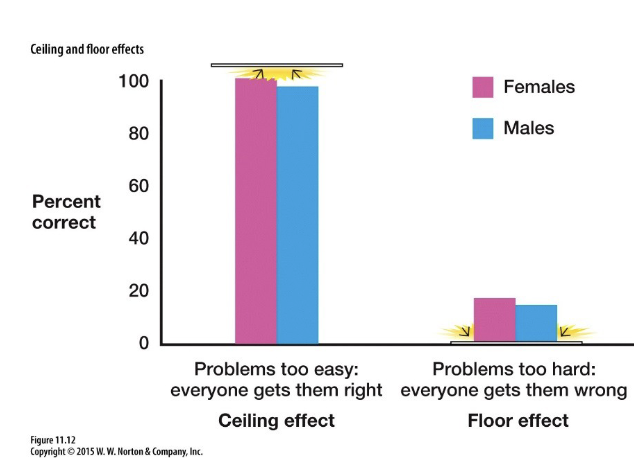
how does manipulation checks help detect weak manipulations, ceilings, and floors
manipulation check: separate dependent variable that experimenters include in a study, specifically to make sure the manipulation worked (IV has intended impact)
For example, in the anxiety study, after telling people they were going to receive a 10-volt, 50-volt, or 100-volt shock, the researchers might have asked: How anxious are you right now, on a scale of 1 to 10? If the manipulation check showed that participants in all three groups felt nearly the same level of anxiety
(A) These results suggest the anxiety manipulation did not work because people at all three levels of the independent variable reported being equally anxious. (B) These results suggest the manipulation did work because the anxiety of people in the three independent variable groups did vary in the expected way. The error bars depict fabricated 95%
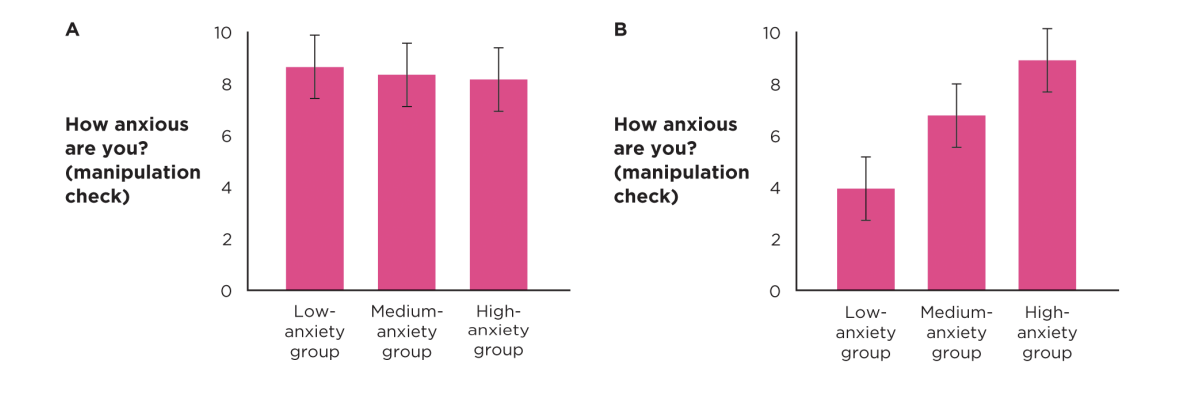
what causes large within group variability
measurement error
pre existing individual differences
situation noise
mesurement error
human or instrument factor that can randomly inflate or deflate a person’s true score on the dependent variable. For example, a person who is 160 centimeters tall might be measured at 160.25 cm because of the angle of vision of the person using the meter stick, or they might be recorded as 159.75 cm because they slouched a bit.
Measurement error is reduced when the reliability of the measure goes up and when precise measurement systems are used
Measurement error is also reduced when a large sample is used
Errors more likely to balance/cancel each other ou
pre existing individual differences
impact response/sensitivity to treatment
normal mood for people can vary
situation noise
Variability in external situation can create within-group variability
smell of the nearby coffee shop might make some participants feel cozy, seeing friends at the next table might make some feel extra happy
Think through possible controls before study